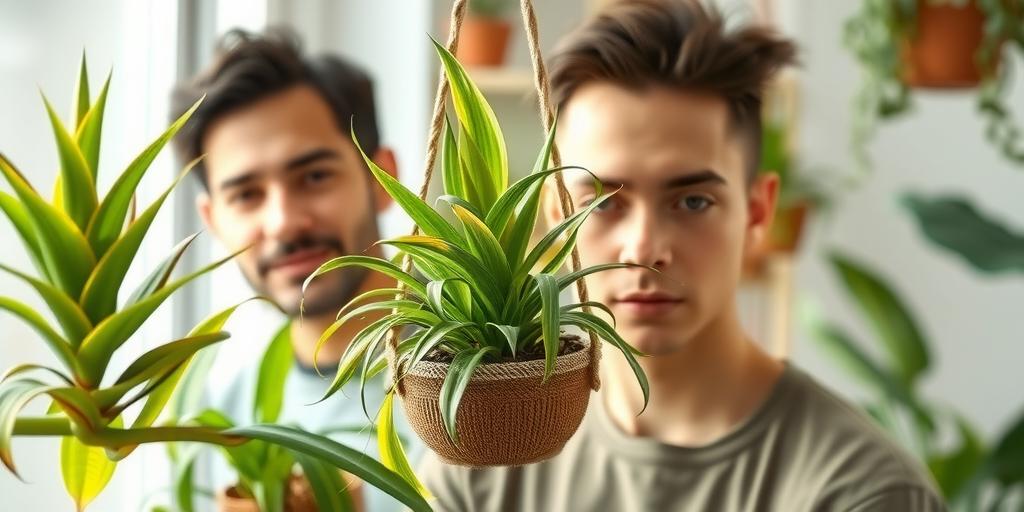
Best Low Light Hanging Plants for Air Purification (2025)
Discover the best low-light hanging plants that purify indoor air! These easy-care, oxygen-boosting plants thrive in dim spaces while removing toxins—perfect for homes and offices.
Introduction
Did you know indoor air can be up to 5 times more polluted than outdoor air? Luckily, nature has a solution—low-light hanging plants that filter toxins while adding greenery to your space! Whether you have a dimly lit apartment or a shady office corner, these air-purifying plants thrive with minimal sunlight and care. In this guide, we’ll explore the best options, their benefits, and how to keep them lush. Let’s dive in!
Why Choose Low Light Hanging Plants for Air Purification?
If you’re looking for a simple yet effective way to improve your indoor air quality, low light hanging plants are a fantastic choice. Many common household toxins—like formaldehyde (found in furniture and cleaning products) and benzene (present in paints and plastics)—can be filtered out by these natural air purifiers. Unlike bulky air filters, plants work silently while adding a touch of greenery to your space.
Another perk? They’re perfect for small spaces. Whether you hang them near a window, on a shelf, or even in a dim corner, these plants adapt well without demanding prime real estate. Plus, if you’re new to plant care or have a busy schedule, low light hanging plants are forgiving. They don’t need constant attention, making them ideal for beginners or forgetful plant parents.
Beyond air purification, these plants also contribute to mental well-being. Studies show that being around greenery can reduce stress, boost mood, and even improve focus—making them a great addition to home offices or bedrooms.
Top 8 Low Light Hanging Plants That Purify Air
1. Spider Plant (Chlorophytum comosum)
Spider plants are air-purifying champions, removing formaldehyde, xylene, and even carbon monoxide from your home. They thrive in indirect light and only need watering when the soil feels dry to the touch. One of their best features? They produce tiny offshoots called “pups,” which you can easily propagate to grow more plants—great for sharing with friends!
2. Pothos (Epipremnum aureum)
Pothos is a favorite for its hardiness and fast growth. It tackles benzene, formaldehyde, and toluene, making it a powerful air cleaner. This plant does well in low light and prefers its soil to dry out between waterings. Its long, trailing vines make it perfect for hanging baskets, where it can cascade beautifully.
3. English Ivy (Hedera helix)
English Ivy is particularly effective at removing mold spores and airborne pollutants. It prefers cooler temperatures and benefits from occasional misting to maintain humidity. Because it loves moisture, it’s an excellent choice for bathrooms. Just keep it out of reach of pets, as it can be toxic if ingested.
4. Boston Fern (Nephrolepis exaltata)
With its lush, feathery fronds, the Boston Fern adds elegance while filtering formaldehyde and xylene. It thrives in humid environments, so keep the soil consistently moist. If your home is dry, misting or placing a pebble tray nearby can help maintain the humidity it craves.
5. Philodendron Heartleaf (Philodendron hederaceum)
This charming plant, with its heart-shaped leaves, is great at removing formaldehyde and other volatile organic compounds (VOCs). It tolerates low light well and only needs watering about once a week. Its trailing vines make it a lovely choice for hanging planters.
6. Devil’s Ivy (Scindapsus pictus)
Often confused with pothos, Devil’s Ivy has striking silvery variegation that adds visual interest. It removes benzene and formaldehyde and can survive in low light, though it prefers bright, indirect light when possible. Let the soil dry slightly between waterings to prevent root rot.
7. Chinese Evergreen (Aglaonema)
Chinese Evergreen is a low-maintenance plant with stunning patterned leaves. It’s excellent at filtering benzene and formaldehyde and adapts well to low light. Water moderately, allowing the top inch of soil to dry out before the next watering.
8. String of Pearls (Senecio rowleyanus)
This unique succulent isn’t just eye-catching—it also helps remove airborne toxins. While it prefers bright, indirect light, it can tolerate some shade. Its drought-tolerant nature makes it perfect for those who occasionally forget to water. Just be careful not to overwater, as its pearl-like leaves store moisture.
How to Care for Low Light Hanging Plants
Watering
Overwatering is one of the biggest mistakes with hanging plants. Always check the soil moisture before watering—stick your finger about an inch deep. If it feels dry, it’s time to water. If not, wait a few more days. Most low light plants prefer slightly dry conditions over soggy soil.
Light Needs
While these plants tolerate low light, they still need some indirect or filtered sunlight to thrive. Avoid placing them in completely dark corners. A spot near a north-facing window or a few feet away from an east-facing one is ideal.
Humidity
Many hanging plants, like ferns and ivy, love humidity. If your home is dry, mist them occasionally or place a tray of water and pebbles beneath their pots to increase moisture in the air.
Fertilizing
During the growing season (spring and summer), feed your plants with a diluted liquid fertilizer about once a month. Reduce or stop fertilizing in fall and winter when growth slows down.
Pruning
Regularly trim dead or yellowing leaves to encourage new growth and keep your plant looking tidy. For trailing plants like pothos or philodendron, occasional pruning can help maintain a fuller appearance.
Best Places to Hang Air-Purifying Plants
Bathrooms
Plants like Boston Ferns and English Ivy thrive in the high humidity of bathrooms. They’ll help filter out mold spores and other pollutants while adding a spa-like feel.
Bedrooms
Spider plants and pothos are excellent choices for bedrooms because they release oxygen at night, promoting better sleep. Plus, their calming greenery can help reduce stress.
Home Offices
Hang a pothos or English Ivy near your workspace to boost focus and reduce indoor toxins. Their trailing vines also add a refreshing touch to your desk area.
Kitchens
Philodendrons or herbs like trailing rosemary (if you have some light) can help remove kitchen fumes and add a fresh, natural vibe. Just keep them away from direct heat sources.
By choosing the right plants and placing them strategically, you can enjoy cleaner air, a more beautiful home, and the mental benefits of greenery—all with minimal effort.
Conclusion
Who says you need bright sunlight to enjoy clean air and lush greenery? These low-light hanging plants are natural air purifiers that thrive in dim spaces with minimal care. Whether you pick a cascading pothos or a graceful Boston fern, each plant brings beauty and health benefits to your home. Ready to breathe easier? Pick your favorite and start hanging!
